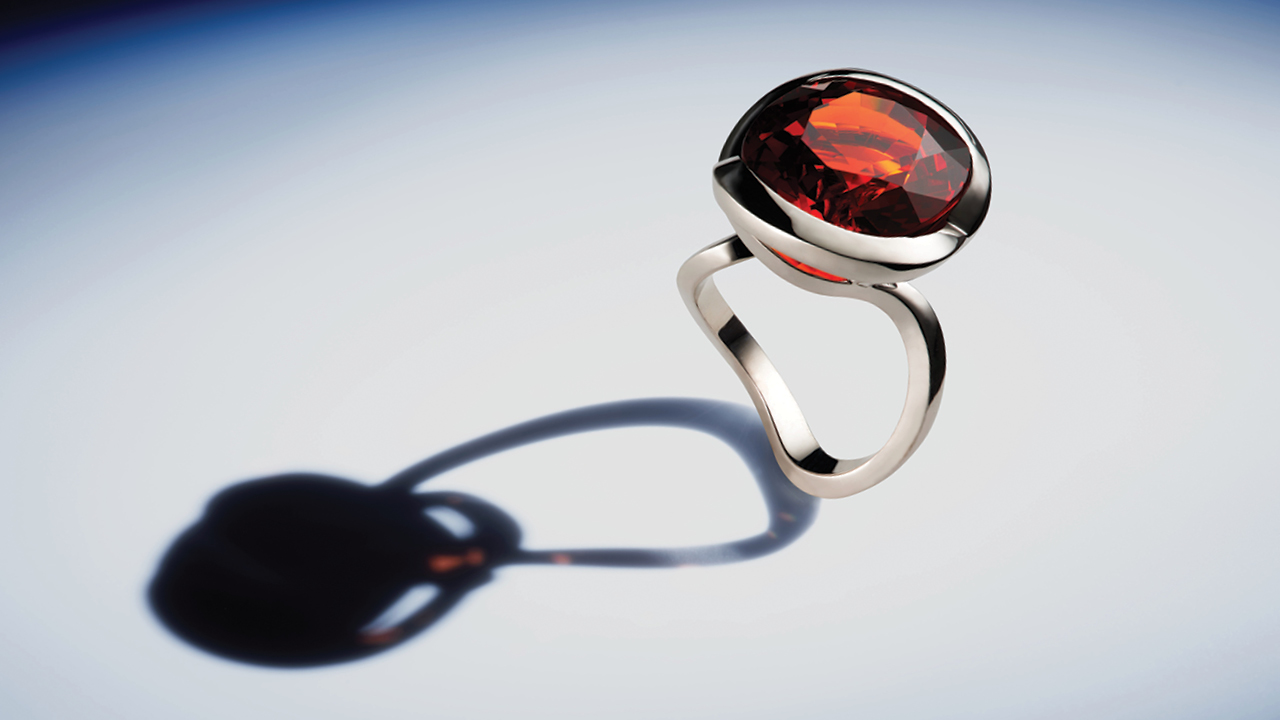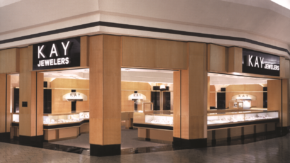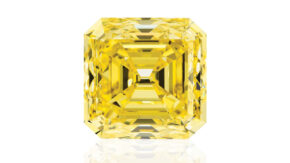Designers, retailers and the end consumer are all saying “I do” to colored-gemstone engagement rings. The growing desire for brightly hued stones in bridal stems from a combination of factors: Couples are searching for something distinctive to symbolize their relationship, vivid color is trending generally in all classifications of jewelry, and the controversy over lab-grown diamonds continues. Here, we talk to retailers and designers about the trend of colored-gem center stones, who’s choosing them and why, the most up-and-coming hues, and whether this direction in bridal is here to stay.
A new generation
“The desire for colored gemstones has been inching its way to popularity over the past three to five years,” says Lauren Wolf, designer of Lauren Wolf Jewelry and owner of retailer Esqueleto, which has stores in California and New York. “The white-diamond trend has fallen off, and the consumer is looking for something more personalized and unique to them.”
Olivier Reza is seeing a somewhat slower shift. “Habits are not changing overnight, but colored gemstones in bridal are increasingly considered an option,” says the designer and owner of multigenerational New York jeweler Reza, which his father originally started in Paris. “[The gemstone trend] started around the millennium as colored stones began showing up more in fine jewelry. The ’90s were a decade dominated by diamonds, but in today’s market, every classification of jewelry features color, [and this] has also influenced engagement rings.”
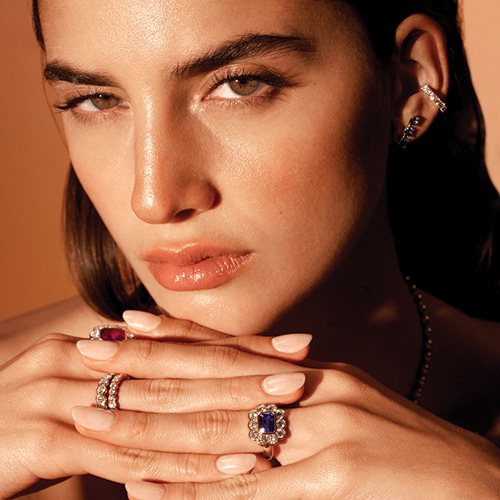
As for who’s buying these rings, “the newer generation definitely has more interest in them,” reports Reza. “They were raised with color, personalization, and rule-breaking fashion.”
Michelle Berlinger of Los Angeles-based jewelry brand Berlinger agrees. “For us, it’s the millennial or Gen Z shoppers who are all about individual style, [who] are drawn to more unexpected pieces or customization in their jewelry, and who want to stand out from their friends and peers.”
Replacing diamonds?
What makes couples choose colored stones over diamonds? The individuality factor is a strong one, according to designers, as is the sentimental factor.
“It revolves around personal preference, which often stems from seeing a family member wear a certain stone over the years,” explains Grace Lee of the eponymous Los Angeles-based brand. “Sometimes it correlates to one or both of the couple’s birthstones.”
Reza echoes that sentiment. “Colored gemstones are a way to express the wearer’s inclination for choosing hues that make each ring more unique. Additionally, the wearer might gravitate toward gems that are rarer, making them a better investment.”
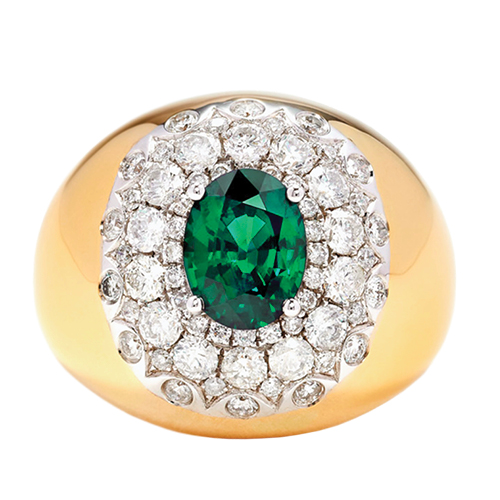
and diamonds (Yvonne Léon)
Berlinger has a different take: “There are still lingering ethical concerns around diamonds, and if the bride-to-be wants a natural and not a lab-created stone, [couples] tend to turn toward colored stones as an alternative.”
Wolf — who also co-created and organizes jewelry fair Melee the Show — concurs. “The hype around lab-created diamonds versus natural diamonds has forced some consumers in a different direction, opting out of a diamond altogether.”
Sapphires, emeralds and accent stones
Historically, sapphires and emeralds were front and center in the antique and vintage rings that graced nobility, Hollywood royalty and socialites. Think actresses Joan Crawford, Carol Lombard, Myrna Loy and Jean Harlow, all of whom wore sapphire engagement rings. Duchess of Windsor Wallis Simpson and former US First Lady Jacqueline Kennedy owned emerald engagement rings — and of course, there’s Princess Diana’s famous sapphire engagement ring, which Princess of Wales Kate Middleton wears today.
Back then, these gems were not as “alternative” as they are today; years of De Beers’ “A Diamond Is Forever” campaign have since changed the norm. Now, however, we are starting to view colored stones as trend-worthy again.
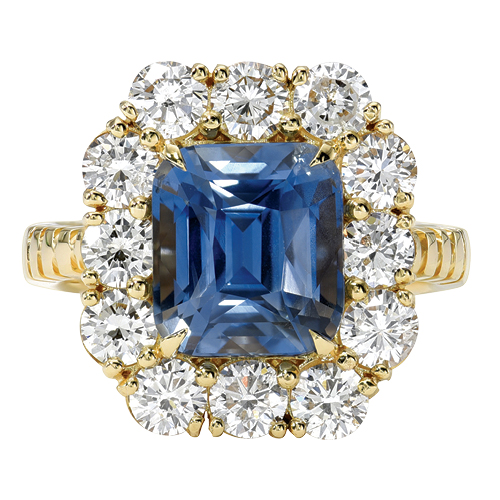
“There is a huge uptick in sapphire for center stones, with a major focus on blue sapphires, [but also] sapphires in lighter blue, green, purple and color-changing variations,” says Wolf.
While Reza has “found sapphires and emeralds to be an especially popular choice among our clients…we also see them moving toward different options.”
Berlinger cites sapphires and emeralds as well, but says her customers “are asking for morganite and aquamarine for the color and more accessible pricing.”
Style-wise, multi-stone rings tend to dominate, say designers, though there is interest in singles as well.
“Diamond accents are still important to elevate the look, so we’re primarily seeing halo engagement rings with colored gems as center stones,” reports Berlinger.
For Wolf, meanwhile, “solitaires and three stone-rings continue to be the options in highest demand.”
Lee has found that “clients who choose colored gemstones tend go much larger, in the 3-carat-plus range. Most popular are toi et moi or multi-stone settings with three or more stones.”
Ongoing value
Retailers agree that margins for top-grade colored stones are around the same as for diamonds, and foresee bridal shoppers choosing these gems for some time to come.
“There is good value in purchasing a sapphire ring for your forever ring,” asserts Wolf. “The one-of-a-kind nature of sapphires and emeralds will help continue the trend of bridal jewelry for colored stones.”
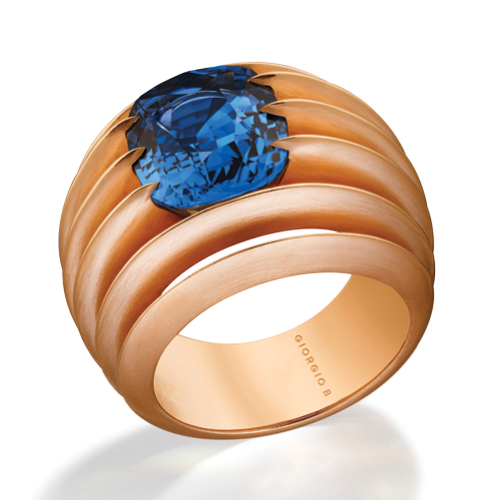
The increasing emphasis on design will also keep it going, Berlinger predicts. “Consumers will continue to seek out alternative stones as the collective style of engagement rings focuses less on diamonds and more on the style of the ring itself.”
Reza agrees. “The shift to [rarer and more] uncommon gems and the preference for individuality and one-of-a-kind designs is inspiring much more color and diversity in the future of bridal jewelry.”
Image: Reza Knot ring with a 19.62-carat spessartite garnet. (Reza)
This article is from the May-June 2024 issue of Rapaport Magazine. View other articles here.
Stay up to date by signing up for our diamond and jewelry industry news and analysis.
